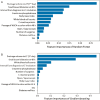Machine Learning Predicts the Need for Surgical Intervention in Adhesive Small Bowel Obstruction
- PMID: 39473722
- PMCID: PMC11513430
- DOI: 10.23922/jarc.2024-036
Machine Learning Predicts the Need for Surgical Intervention in Adhesive Small Bowel Obstruction
Abstract
Objectives: To explore the predictive performance on the need for surgical intervention in patients with adhesive small bowel obstruction (ASBO) using machine-learning (ML) algorithms and investigate the optimal timing for transition to surgery.
Methods: One hundred and six patients with ASBO who initially underwent long transnasal intestinal tube (LT) decompression were enrolled in this retrospective study. Traditional logistic regression analysis and ML algorithms were used to evaluate the risk of need for surgical intervention.
Results: Non-operative management (NOM) by LT decompression failed in 28 patients (26%). Multivariate logistic regression analysis identified a drainage volume ≥665 ml via LT on day 1, interval between ASBO diagnosis and LT intubation, and small bowel dilatation at 48 h after LT intubation to be independent predictors of transition to surgery (odds ratios 7.10, 1.42, and 19.81, respectively; 95% confidence intervals 1.63-30.94, 1.00-2.02, and 3.04-129.10; P-values 0.009, 0.047, and 0.002). The random forest algorithm showed the best predictive performance of five ML algorithms tested, with an area under the curve of 0.889, accuracy of 0.864, and precision of 0.667 in the test set. 97.4% of patients without transition to surgery (n=78) had passes of first flatus until three days.
Conclusions: This is the first study to demonstrate that ML algorithm can predict the need for surgery in patients with ASBO. The guideline recommended period for initial NOM of 72 h seems to be reasonable. These findings can be used to develop a framework for earlier clinical decision-making in these patients.
Keywords: adhesive small bowel obstruction; long transnasal intestinal tube; machine-learning; non-operative management; surgery.
Copyright © 2024 The Japan Society of Coloproctology.
Conflict of interest statement
Conflicts of Interest There are no conflicts of interest.
Figures




Similar articles
-
Predicting postoperative adhesive small bowel obstruction in infants under 3 months with intestinal malrotation: a random forest approach.J Pediatr (Rio J). 2025 Mar-Apr;101(2):282-289. doi: 10.1016/j.jped.2024.11.011. Epub 2025 Jan 21. J Pediatr (Rio J). 2025. PMID: 39765335 Free PMC article.
-
Bologna Guidelines for Diagnosis and Management of Adhesive Small Bowel Obstruction (ASBO): 2010 Evidence-Based Guidelines of the World Society of Emergency Surgery.World J Emerg Surg. 2011 Jan 21;6:5. doi: 10.1186/1749-7922-6-5. World J Emerg Surg. 2011. PMID: 21255429 Free PMC article.
-
Geographic Variation in Operative Management of Adhesive Small Bowel Obstruction.J Surg Res. 2023 Jun;286:57-64. doi: 10.1016/j.jss.2022.12.040. Epub 2023 Feb 6. J Surg Res. 2023. PMID: 36753950 Free PMC article.
-
Bologna guidelines for diagnosis and management of adhesive small bowel obstruction (ASBO): 2017 update of the evidence-based guidelines from the world society of emergency surgery ASBO working group.World J Emerg Surg. 2018 Jun 19;13:24. doi: 10.1186/s13017-018-0185-2. eCollection 2018. World J Emerg Surg. 2018. PMID: 29946347 Free PMC article. Review.
-
Current management of adhesive small bowel obstruction.ANZ J Surg. 2018 Nov;88(11):1117-1122. doi: 10.1111/ans.14556. Epub 2018 May 14. ANZ J Surg. 2018. PMID: 29756678 Review.
References
-
- Aquina CT, Becerra AZ, Probst CP, et al. Patients With Adhesive Small Bowel Obstruction Should Be Primarily Managed by a Surgical Team. Ann Surg. 2016 Sep; 264(3): 437-47. - PubMed
-
- Matsuda A, Yamada T, Ohta R, et al. Surgical Site Infections in Gastroenterological Surgery. J Nippon Med Sch. 2023 Mar; 90(1): 2-10. - PubMed
-
- Kossi JA, Salminen PT, Laato MK. Surgical workload and cost of postoperative adhesion-related intestinal obstruction: importance of previous surgery. World J Surg. 2004 Jul; 28(7): 666-70. - PubMed
-
- Parikh JA, Ko CY, Maggard MA, et al. What is the rate of small bowel obstruction after colectomy? Am Surg. 2008 Oct; 74(10): 1001-5. - PubMed

